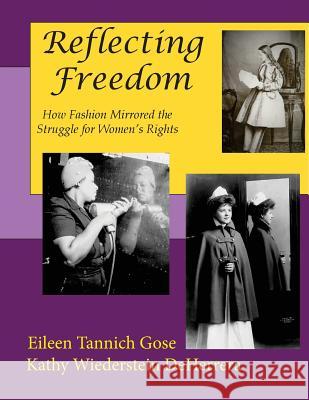Reflecting Freedom: How Fashion Mirrored the Struggle for Women's Rights (Color Edition) » książka
Reflecting Freedom: How Fashion Mirrored the Struggle for Women's Rights (Color Edition)
ISBN-13: 9781543133318 / Angielski / Miękka / 2017 / 360 str.
Reflecting Freedom: How Fashion Mirrored the Struggle for Women's Rights (Color Edition)
ISBN-13: 9781543133318 / Angielski / Miękka / 2017 / 360 str.
(netto: 310,23 VAT: 5%)
Najniższa cena z 30 dni: 325,74
ok. 16-18 dni roboczych
Bez gwarancji dostawy przed świętami
Darmowa dostawa!
This book has over 900 images, including over 300 in color. This book explores how women's struggle for social and political equality is reflected in their clothing. For example, were enormous hoop skirts, tightly laced corsets, controversial trousers, or revealing miniskirts simply fashion trends, or deliberate statements about societal values? Did soft, flowing feminine dresses, high heels, curls and pearls merely reflect popular changes in style, or instead, perhaps show a step back in women's equality? Historic images and other primary sources reveal an intriguing relationship between women fighting for their rights and their image reflected in the mirror. There are a multitude of books about women's fashions and numerous manuscripts addressing women's fight for rights. However, unlike other works, this book explores the relationship between the two topics, revealing the important meaning of specific changes in women's fashions. Other books deal with this subject primarily with a narrow focus, or only as a small part of the context; however, this book is exceptional because the entire work addresses the relationship between women's fashions and their struggle for equality--including the losses as well as the gains. And uniquely, this book explores the thesis in depth, and from the time of our foremothers up to the women of the millennium. This well-researched, thoroughly documented and thoughtfully written book will appeal to a popular audience. The authors used primary sources including hundreds of original photographs, postcards, advertisements, letters and speeches. Furthermore, the topics of female fashion and women's rights are examined within the context of society. Whether women were trapped in a crowded tenement building, lived behind a white picket fence or struggled to combine a career and a family, their lives were interconnected and influenced by events and attitudes in the community, the county and the world. Readers will realize how women's clothing measured their progress in the fight for equality and their place in the man's world.
Zawartość książki może nie spełniać oczekiwań – reklamacje nie obejmują treści, która mogła nie być redakcyjnie ani merytorycznie opracowana.











